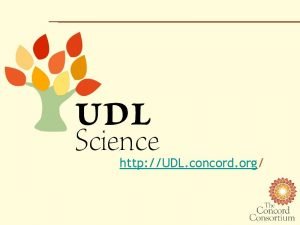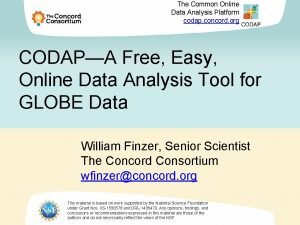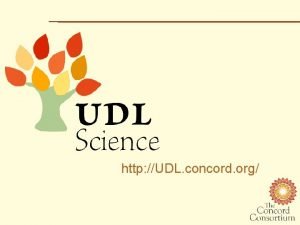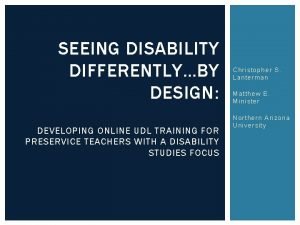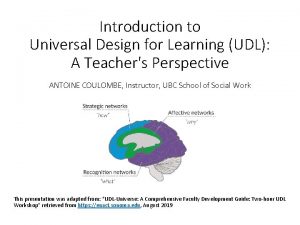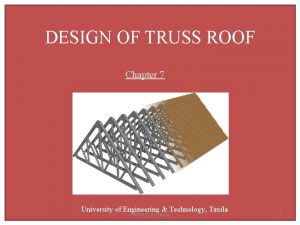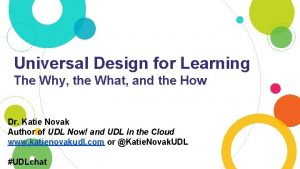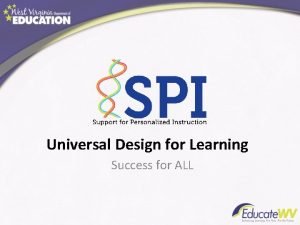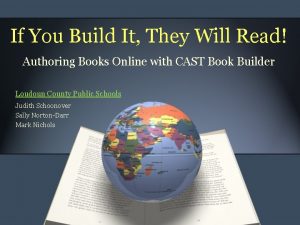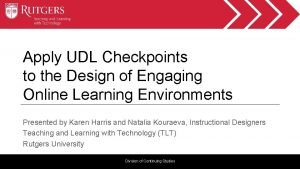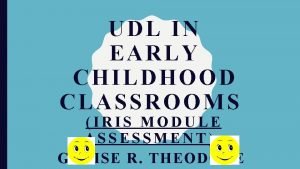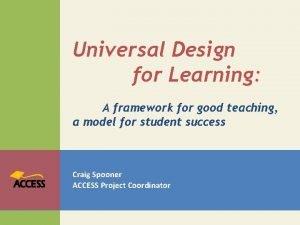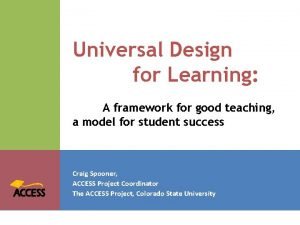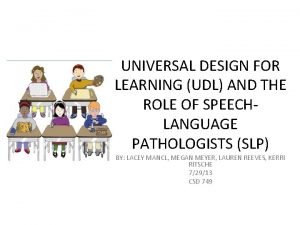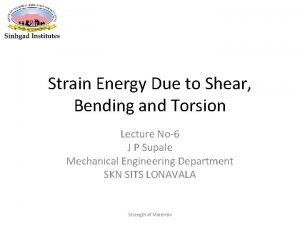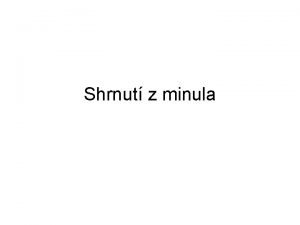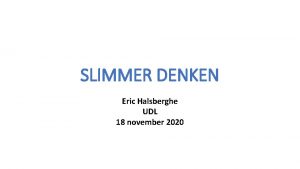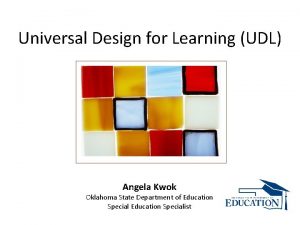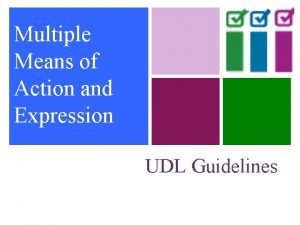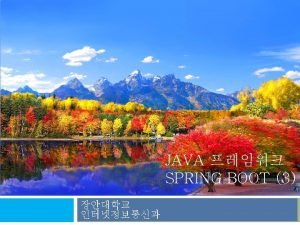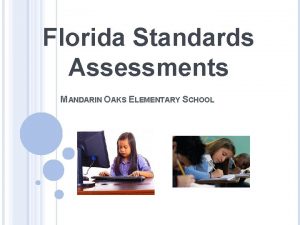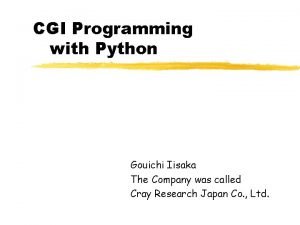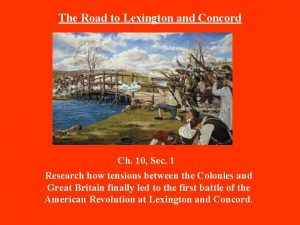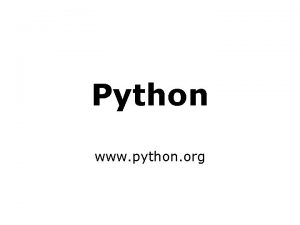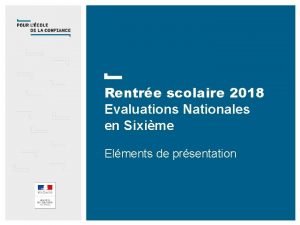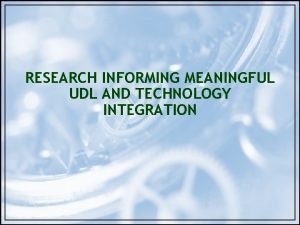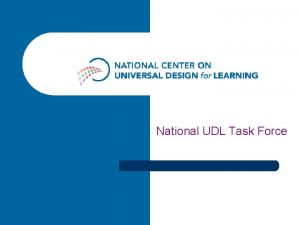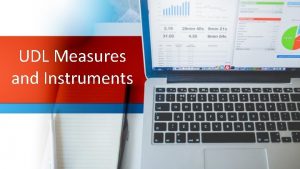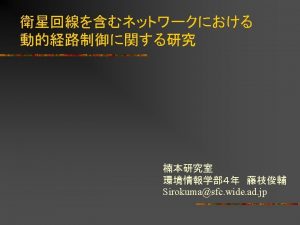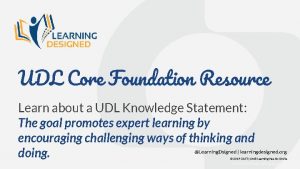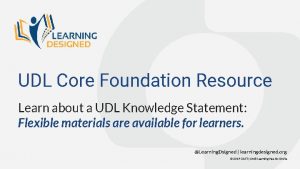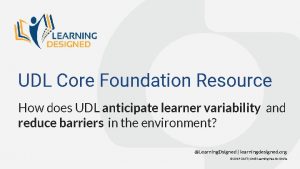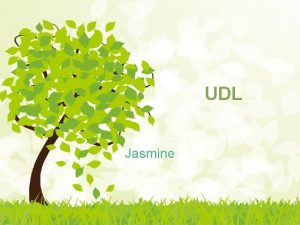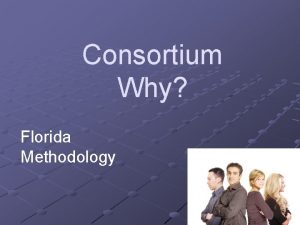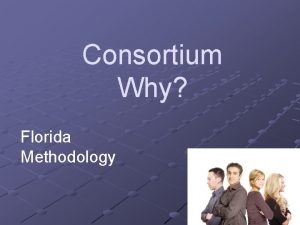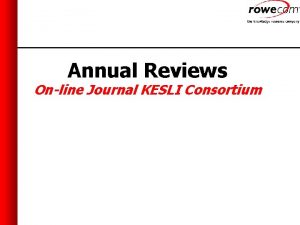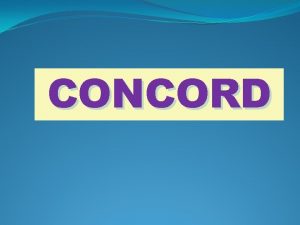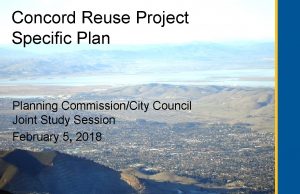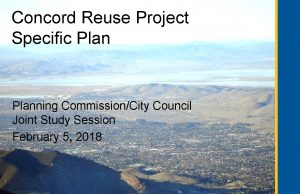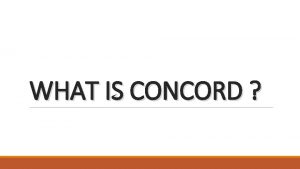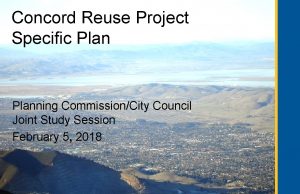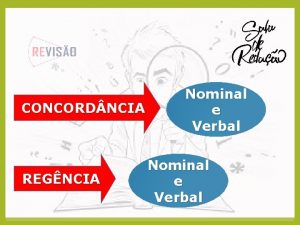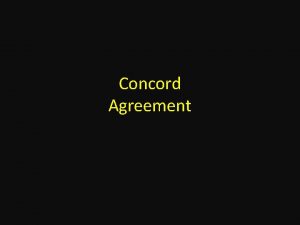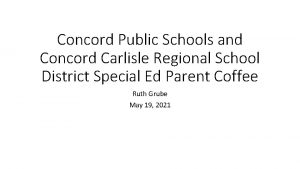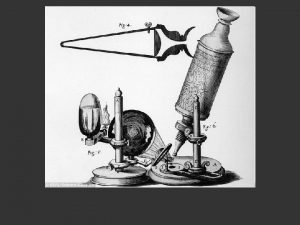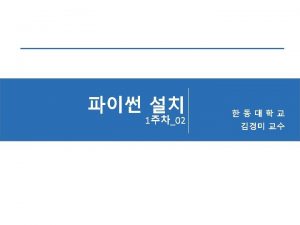http UDL concord org The Concord Consortium is


























- Slides: 26

http: //UDL. concord. org/

The Concord Consortium is proud to announce the Post-Textbook UDL Materials project. These materials are based upon work supported by the National Science Foundation under Grant No. ESI-0628242. Any opinions, findings, and conclusions or recommendations expressed in this material are those of the author(s) and do not necessarily reflect the views of the National Science Foundation.

Universal Design for Learning “Applying universal design to learning materials and activities can increase access for learners with wide disparities in their abilities to see, hear, speak, move, read, write, understand English, attend, organize, focus, engage, and remember. ” -- Rose & Meyer, 2000, 2002

UDL: Instructional Materials To ensure equal access for all students by using flexible materials to increase opportunities for individualization. • Individualized display • Individualized selection • Individualized sequences © CAST

UDL: Teaching Methods UDL in Science will provide effective instruction for all students. Use classroom strategies to increase opportunities for individualization by: • Use flexible grouping • Encourage peer support • Practice collaborative teaching • Use customizable instructional media and materials © CAST

UDL: Assessment Methods UDL in Science will accurately measure progress for all students. Use assessments to optimally inform individualized instruction by: • Assess early and often to monitor progress • Provide timely feedback • Provide feedback on instructional options © CAST

UDL Science: Why? There are no classroom-ready STEM curriculum materials that use Universal Design for Learning. There is a particular urgency to develop UDL materials now because the 2004 Individuals with Disabilities Education Act (IDEA) included provisions for a process that will result in a voluntary National Instructional Materials Accessibility Standard (NIMAS). Exemplars are needed that demonstrate what is possible when UDL materials are designed from the start for electronic delivery.

UDL Science: Goals The goal of this project is to create practical science materials designed with UDL principles for students and teachers in inclusive classrooms. The project will create sufficient materials to test the effectiveness of the approach and provide an exemplar that can inspire additional content and further development.

UDL Science: Modules The project will develop seven modules that each require two to three weeks of class time. Each will include a driving question that leads to investigations with probes and atomic-scale models. Energy conservation and conversion will be highlighted in each module, providing a unifying theme.

UDL Science: Modules Why are there clouds? This earth systems module focuses on weather, air pressure and temperature, latent heat, and evaporation. What do plants eat? This is a life science module that introduces light and photosynthesis. Is it getting hotter? This is an ecology module on climate and climate change. Why does water boil? This physical science module addresses states of matter and phase change. What is electricity? This physical science module introduces electrical energy. Discover why it takes two wires to light a bulb. What if there was no friction? This is a physical science module focused on force, motion, and energy at astronomical and atomic scales. Why do we hear sound? This physical science module addresses energy transfer through sound waves. Climb aboard a sound wave and experience different vibrations.

UDL Science The science modules will provide a range of alternatives for the way tools are used in the classroom. • Alternative Representations • Alternative Communications • Alternative Instructional Strategies • Alternative Assessments • Additional Alternatives

Alternative Representations The materials will be constructed from four kinds of objects: text boxes, tables, graphs, and models with a range of display options: • Type of display • Font size and line width • Colors • Multiple languages: English and Spanish • Vocalization: spoken text

Alternative Communications The text can be selected and read in meaningful parts (e. g. , words, phrases, sentences, or paragraphs) and it can explain text using a glossary. Smart Graph, Smart Model and Drawing Tool will be able to describe important features, e. g. , a graph’s maximum, minimum, and slope.

UDL Science: Models and Sensors Each module will include activities that use: • Models Computer models can simulate situations that are hard to see (molecular motion) or hard to understand (complex systems). They allow students to study and manipulate phenomena that are otherwise inaccessible. Students can also modify the models and experiment with different rules and starting conditions. They learn programming and technology skills and science content at the same time. • Sensors Using sensors attached to real-time graphs, students can do real experiments and take vivid and compelling measurements. This encourages active engagement in science and exploration of the natural world. Students also learn the technology underlying the sensors and how they collect and display information.

Alternative Instructional Strategies The materials will be constructed various instructional strategies: • Multiple discovery questions to answer the driving question • Hands-on, probes, Flash or models (ageappropriate • “Glossary” for highlighted tools contextual vocabulary • Leveled “scaffolding” of questions

Alternative Instructional Strategies Scaffolding Level 1: One or more examples of good responses are provided. Students are asked to add to response in their own words. Level 2: The student selects the best of several suggested multiple-choice responses. Level 3: Parts of a response are provided, but the student is asked to fill in missing content. Level 4: Clues are given for data or information that students should use. Level 5: Only context-independent scaffolding is provided.

Alternative Assessments Explicit and embedded assessments: • Tracking (time/action) • Performance assessment ~ multiple choice items ~ open-ended responses ~ drawing responses • Electronic portfolios • Automatically graded pre-post tests

Additional Alternatives Additional alternatives include: • Speed control • Wrap-up - Big ideas portfolio (screen shots) • Coaches • Visual communications • Screen control • Content options (following the 5 E’s - Engage, Explore, Explain, Elaborate, and Evaluate) ~ language arts story ~ four science activities ~ mathematics activity

UDL Science: Sites Four sites were chosen across the United States: Acton, MA, Anchorage, AK, Maryville, MO, and Fresno, CA

UDL Science: Anchorage, AK Anchorage School District enrolls over 50, 000 students with 46% ethnic non-Whites. Over 33% of ASD students now live in poverty, and this proportion is increasing.

UDL Science: Anchorage, AK “The project will be a creative way to help us meet the academic needs of our diverse K-12 population. ” Texas Gail Raymond, K-12 Science Coordinator, Anchorage School District

UDL Science: Acton, MA Douglas Elementary School, in Acton, MA, has a K-6 program with a 25% non-White population. The school has a 13 station computer lab staffed by computer specialists. “Our 21 classroom teachers and 495 students are dedicated to realizing mastery of the state standards and the use of technology to facilitate our understandings. Of course this is a challenge given the wide range of students with whom we work. A project based on Universal Design principles will target the needs that we face to teach ALL students the science concepts that we know they can learn. ” -- Dr. Christopher Whitbeck, Principal

UDL Science: Maryville, MO Horace Mann Laboratory School is located on the campus of Northwest Missouri State University in Maryville, Missouri. Maryville serves a rural, farming region experiencing a high rate of poverty. Currently, they provide free and/or reduced federal lunch program to 15% of the student population and the diversity rate averages between 12% and 15%. “The teachers and administrators at Horace Mann Laboratory School are committed to implementing the tenets of the UDL into our school’s curriculum using theme of ‘energy’ across the third through sixth grades. We are excited to be able to provide all of our students with this sound, technology enhanced, student centered science instruction. ” – Rebecca Belcher, Ph. D. , Director, Horace Mann

UDL Science: Fresno, CA Fresno Unified School District has a very diverse student population of 78, 000 students. More than 80% qualify for free or reduced meals.

UDL Science: Fresno, CA “UDL is exciting because it represents a convergence of thinking about the best uses of technology. It is inspired by the needs of special students, but it can improve the learning of all students. By helping students who are marginalized in traditional classrooms, we will develop educational methods and materials that are flexible and powerful enough to help all students, regardless of their ability. ” – Jerry D. Valadez, Ed. D. , K-12 Science Coordinator, Fresno Unified School District

The Concord Consortium is a nonprofit educational research and development organization based in Concord, Massachusetts. We create interactive materials that exploit the power of information technologies. Our primary goal in all our work is digital equity — improving learning opportunities for all students. http: //udl. concord. org 25 Love Lane Concord, MA 01742 978 -405 -3208
 Concord consortium molecular workbench photosynthesis
Concord consortium molecular workbench photosynthesis Codap concord
Codap concord Concord examples
Concord examples Udl
Udl Ron mace
Ron mace Self weight of roof truss
Self weight of roof truss Mtss and udl
Mtss and udl Iris udl assessment answers
Iris udl assessment answers Udl book builder
Udl book builder Udl checkpoints
Udl checkpoints Iris udl
Iris udl Udl percentage
Udl percentage Udl nontraditional students
Udl nontraditional students Udl
Udl Strain energy stored in a hollow shaft
Strain energy stored in a hollow shaft Fce udl
Fce udl Udl voorbeelden
Udl voorbeelden Difference between udl and differentiation
Difference between udl and differentiation Multiple means of action and expression
Multiple means of action and expression Http //mbs.meb.gov.tr/ http //www.alantercihleri.com
Http //mbs.meb.gov.tr/ http //www.alantercihleri.com Http //pelatihan tik.ung.ac.id
Http //pelatihan tik.ung.ac.id Thymeleaf
Thymeleaf Http://fsassessments.org
Http://fsassessments.org Http://www.python.org/download/
Http://www.python.org/download/ Http://www.pbs.org/ktca/liberty/
Http://www.pbs.org/ktca/liberty/ Www.python.org
Www.python.org Eval.dep.taocloud
Eval.dep.taocloud
